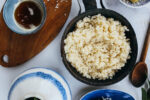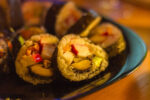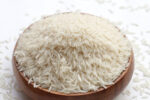Brown rice is a whole grain rice variety that retains its bran and germ layers, making it more nutritious and fibrous compared to white rice. Brown rice comes in various grain sizes, including long, medium, and short-grain varieties. It is known for its chewy texture, nutty flavor, and health benefits due to its higher levels of fiber, vitamins, and minerals.
Characteristics of Brown Rice
Brown rice is minimally processed, which allows it to retain several key components:
- Outer Bran Layer: This outer layer gives brown rice its tan color and is rich in fiber and antioxidants.
- Germ: The germ layer contains essential fatty acids, vitamins (such as Vitamin E), and minerals.
- Nutty Flavor: Brown rice has a more earthy and nutty flavor compared to white rice due to the retained bran and germ.
- Chewy Texture: Because of the bran layer, brown rice has a firmer, chewier texture than white rice.
Types of Brown Rice
- Long-Grain Brown Rice: The grains remain separate when cooked, resulting in a light and fluffy texture. It is commonly used in side dishes and salads.
- Medium-Grain Brown Rice: This type of brown rice is shorter and plumper. When cooked, it becomes tender but with a slightly chewy texture, making it ideal for casseroles and risottos.
- Short-Grain Brown Rice: Short-grain rice is known for being stickier when cooked. It is often used in dishes where a more cohesive texture is desirable, such as sushi or rice bowls.
Nutritional Profile of Brown Rice
Brown rice is considered a more nutritious alternative to white rice due to its higher content of fiber, vitamins, and minerals. A typical serving of cooked brown rice (1 cup) contains:
- Calories: 215
- Carbohydrates: 45g
- Protein: 5g
- Fat: 1.5g
- Fiber: 3.5g
- Vitamins: B vitamins (thiamin, niacin, B6)
- Minerals: Magnesium, manganese, phosphorus, and selenium
Brown rice is particularly rich in magnesium and manganese, both essential for energy production, metabolism, and maintaining healthy bones.
Culinary Uses of Brown Rice
Brown rice can be used in a wide range of culinary applications, from simple side dishes to more complex recipes:
- Brown Rice Pilaf: A nutritious twist on traditional pilaf, made by cooking brown rice in broth with herbs and spices.
- Brown Rice Salad: Often combined with vegetables, nuts, or beans for a hearty and healthy salad.
- Rice Bowls: Brown rice is commonly used as a base for grain bowls, topped with vegetables, proteins, and sauces.
- Stuffed Vegetables: Brown rice can be used as a filling for stuffed peppers, tomatoes, or zucchini.
- Brown Rice Porridge: In some cultures, brown rice is cooked into a porridge-like consistency, often sweetened with honey or topped with fruit.
Preservation of Brown Rice
Since brown rice retains its bran and germ layers, it is more prone to spoilage than white rice due to the presence of natural oils that can go rancid. Below are methods for storing and preserving both uncooked and cooked brown rice:
Storing Uncooked Brown Rice
Uncooked brown rice has a shorter shelf life than white rice due to the oils in the bran layer, which can oxidize over time.
- Pantry Storage: Brown rice can be stored in a cool, dry place in an airtight container. However, it typically only lasts for 6 months to 1 year at room temperature before it begins to spoil.
- Refrigeration: To extend the shelf life, store uncooked brown rice in the refrigerator, where it can last for up to 12-18 months. This is especially useful in warm or humid climates.
- Freezing: For longer-term storage, uncooked brown rice can be frozen in an airtight container or freezer bag. Frozen rice can last for up to 2 years without losing its flavor or nutritional value.
Preserving Cooked Brown Rice in the Fridge
Cooked brown rice is prone to bacterial growth if not stored properly. Here’s how to preserve it safely:
- Cool Quickly: Spread the cooked brown rice on a shallow dish or baking sheet to cool it quickly. This should be done within an hour of cooking.
- Refrigerate Immediately: Transfer the cooled rice into an airtight container and store it in the refrigerator. Cooked brown rice will last for 4-6 days when stored properly.
- Label and Date: Always label and date the container to track how long the rice has been stored.
Reheating Cooked Brown Rice
When reheating cooked brown rice, ensure it reaches a steaming temperature of at least 165°F (74°C) to kill any potential bacteria.
- Microwave: Add a tablespoon of water per cup of rice, cover it with a microwave-safe lid, and heat on high until steaming.
- Stovetop: Place the rice in a saucepan with a splash of water, cover, and heat on medium until fully heated through.
Other Methods of Preserving Cooked Brown Rice
- Freezing Cooked Brown Rice: Brown rice can be frozen after cooking for up to 6 months. Portion the rice into freezer-safe bags or containers, removing as much air as possible before sealing. When reheating, thaw in the refrigerator overnight or reheat directly from frozen using a microwave or stovetop.
- Vacuum Sealing: Cooked brown rice can also be vacuum-sealed before freezing to minimize exposure to air, thus preserving its texture and flavor better.
Health Benefits and Considerations of Brown Rice
Brown rice is packed with health benefits due to its whole-grain status:
- High in Fiber: Brown rice contains about three times more fiber than white rice, which can aid digestion, promote satiety, and help maintain healthy blood sugar levels.
- Rich in Antioxidants: The bran layer of brown rice contains a range of antioxidants, which may help reduce inflammation and protect against oxidative stress.
- Lower Glycemic Index: Brown rice has a lower glycemic index (GI) compared to white rice, meaning it causes slower and more gradual increases in blood sugar levels, making it a better option for individuals with diabetes.
Risks and Considerations in Brown Rice Preservation
- Rancidity: Due to the natural oils in the bran layer, brown rice is more likely to become rancid if not stored correctly. Proper storage in airtight containers, refrigeration, or freezing is necessary to prevent spoilage.
- Bacterial Growth in Cooked Rice: Like all cooked rice, brown rice is susceptible to bacterial contamination, particularly if left at room temperature for too long. It is crucial to refrigerate or freeze rice promptly after cooking to prevent foodborne illnesses.
Conclusion
Brown rice is a nutritious and versatile whole grain that offers numerous health benefits over its white counterpart, including higher fiber, antioxidants, and essential vitamins and minerals. Proper storage is key to preserving its quality, as the oils in the bran layer can spoil if not handled correctly. With effective preservation methods like airtight containers, refrigeration, and freezing, both uncooked and cooked brown rice can maintain its freshness and nutritional value for extended periods.





